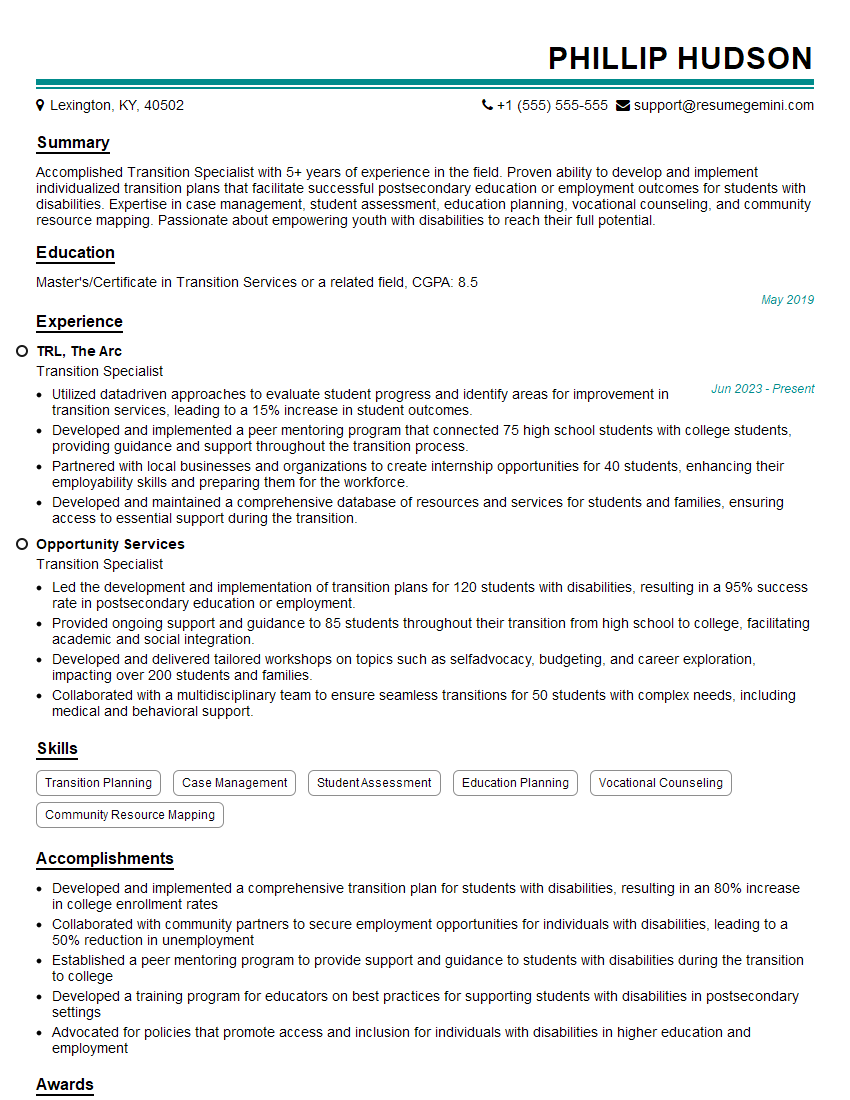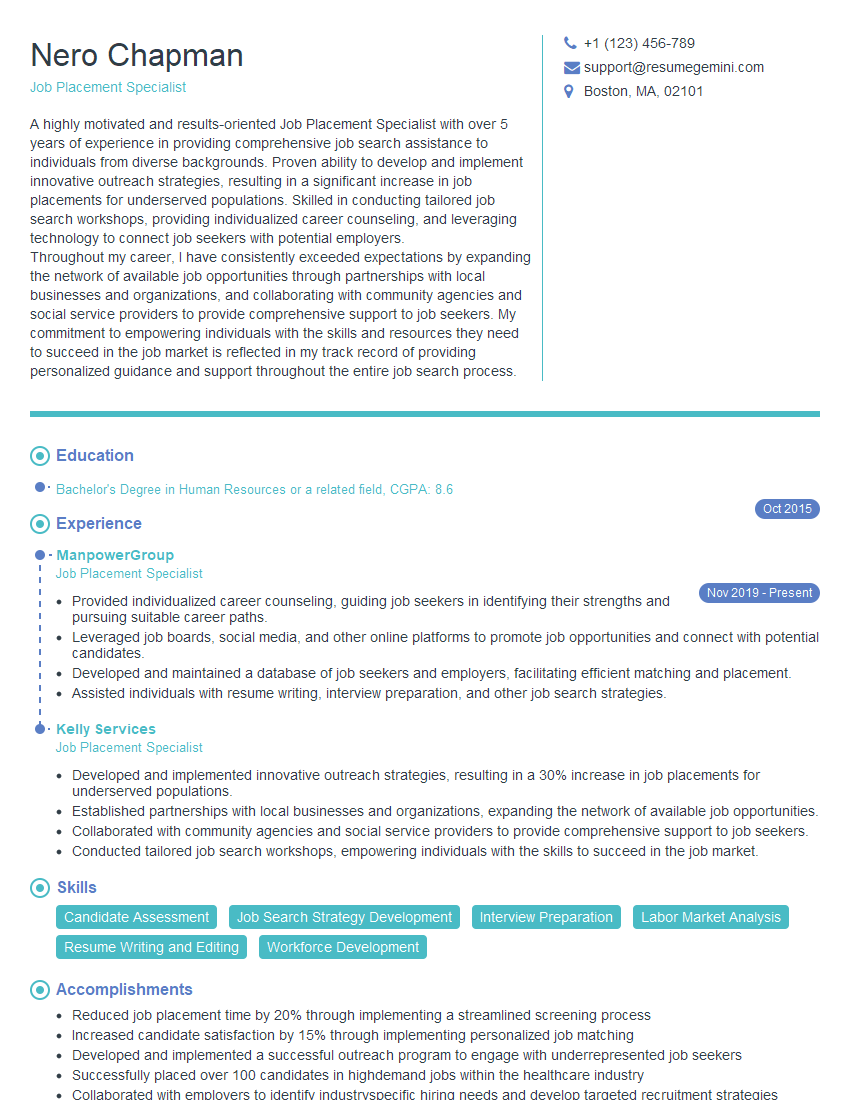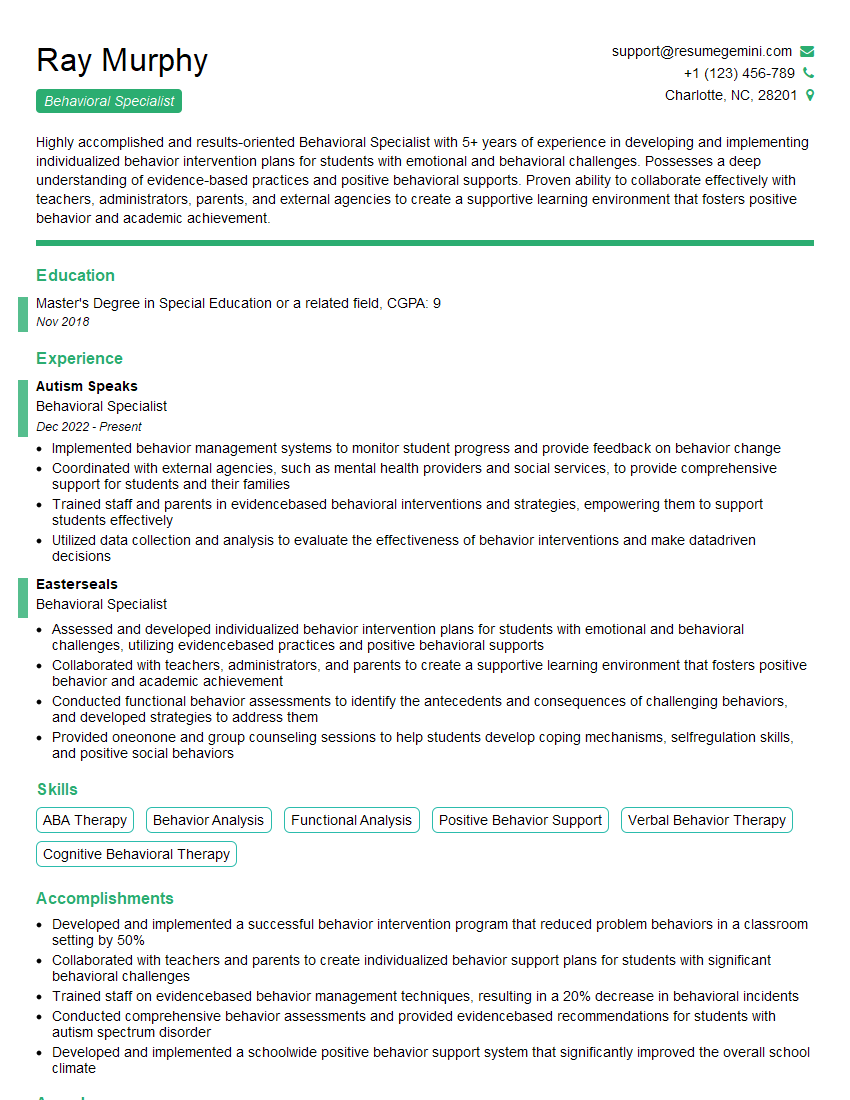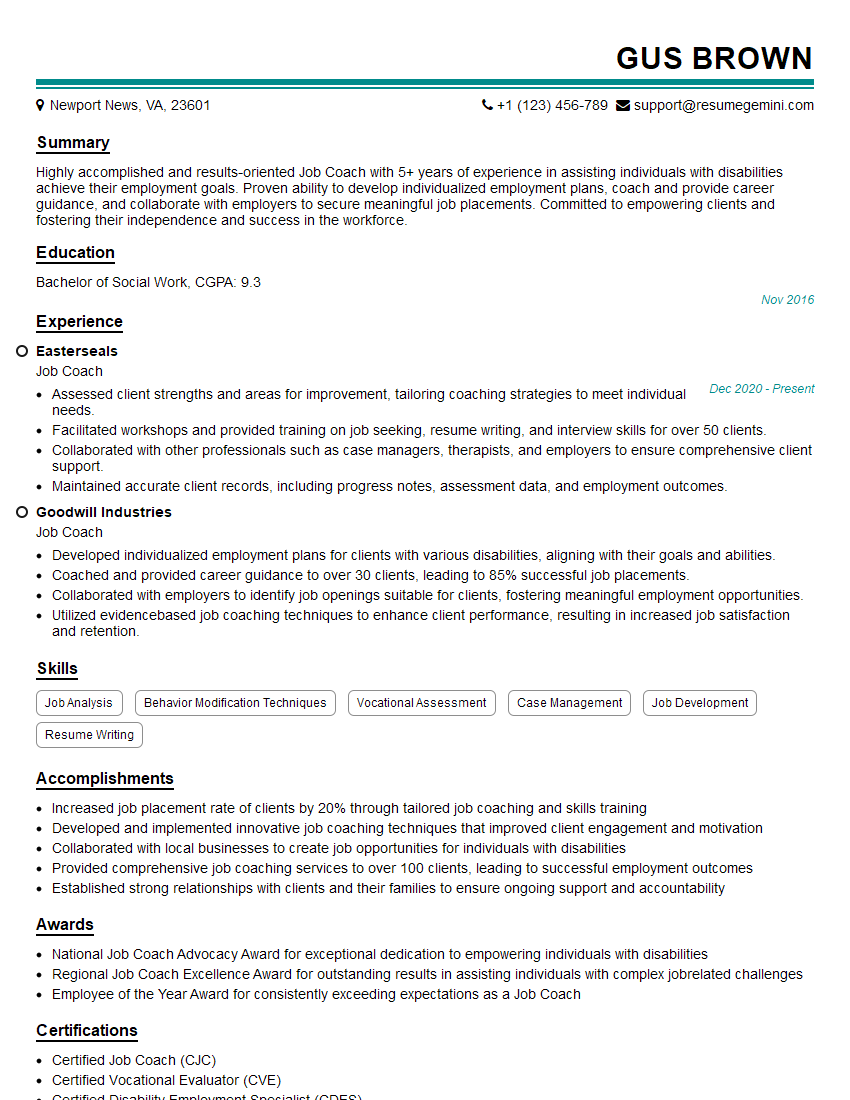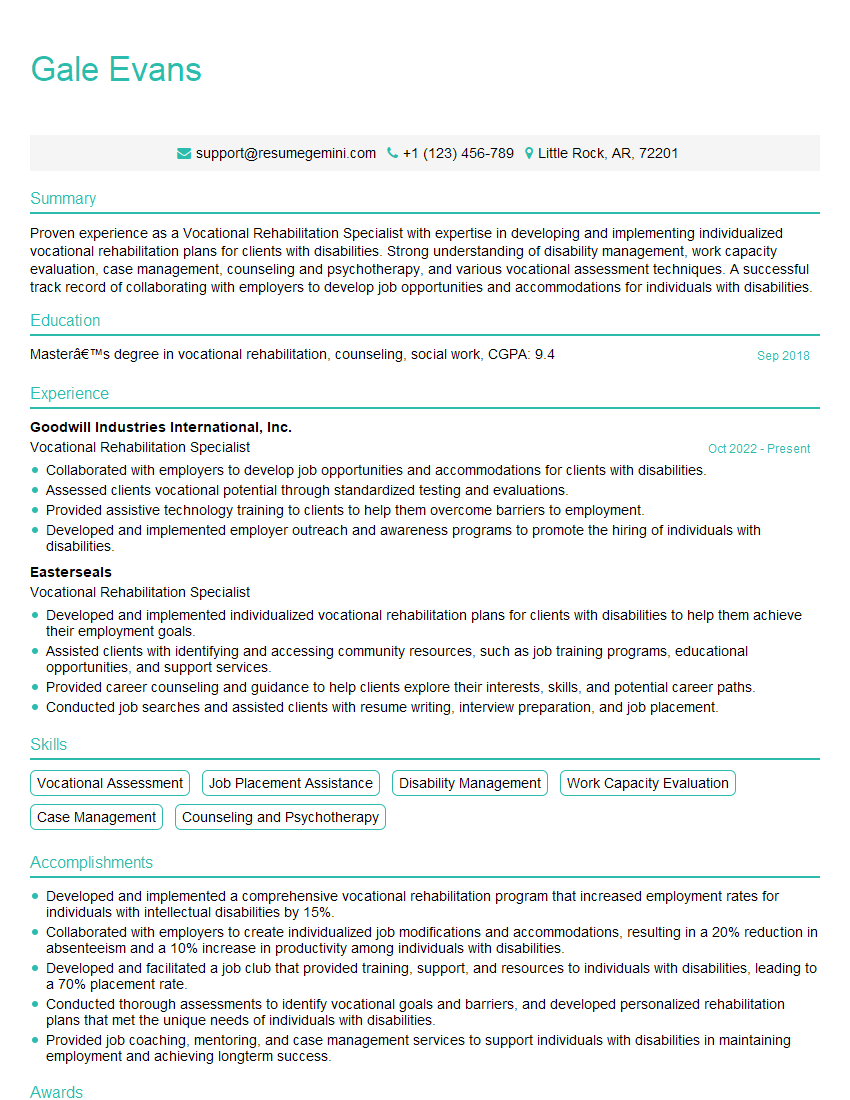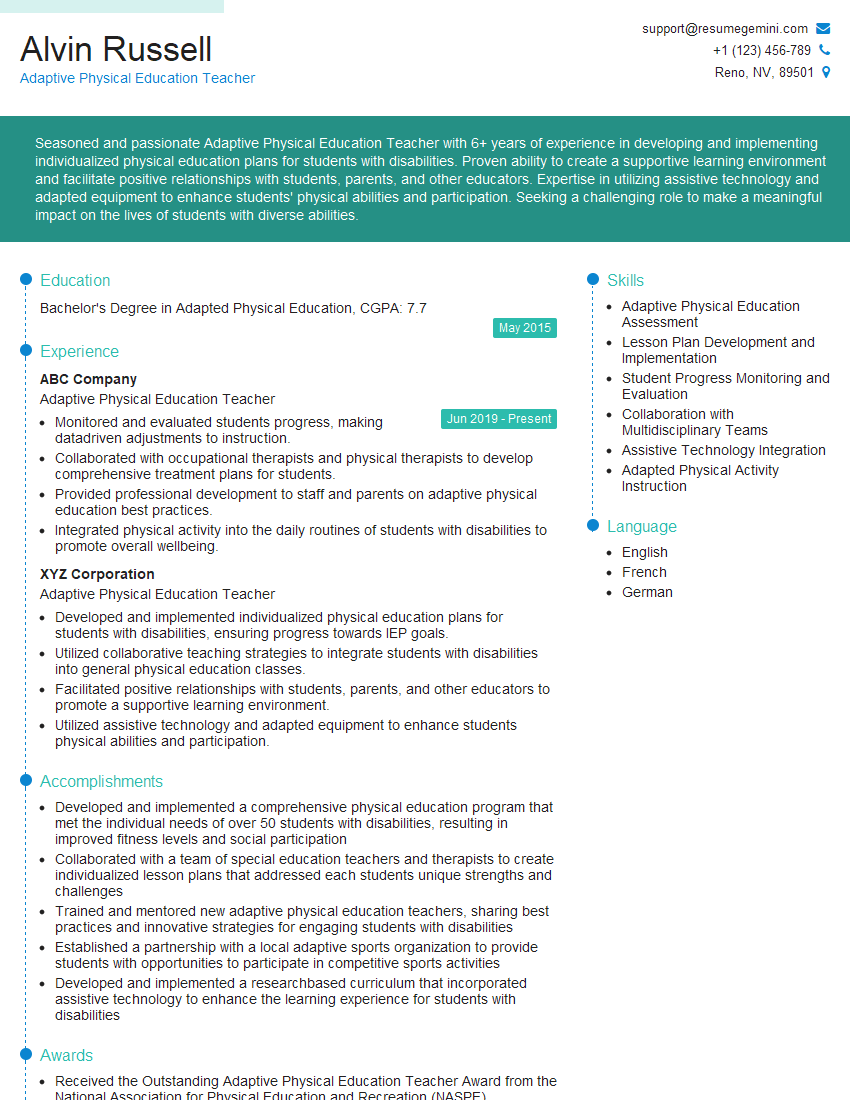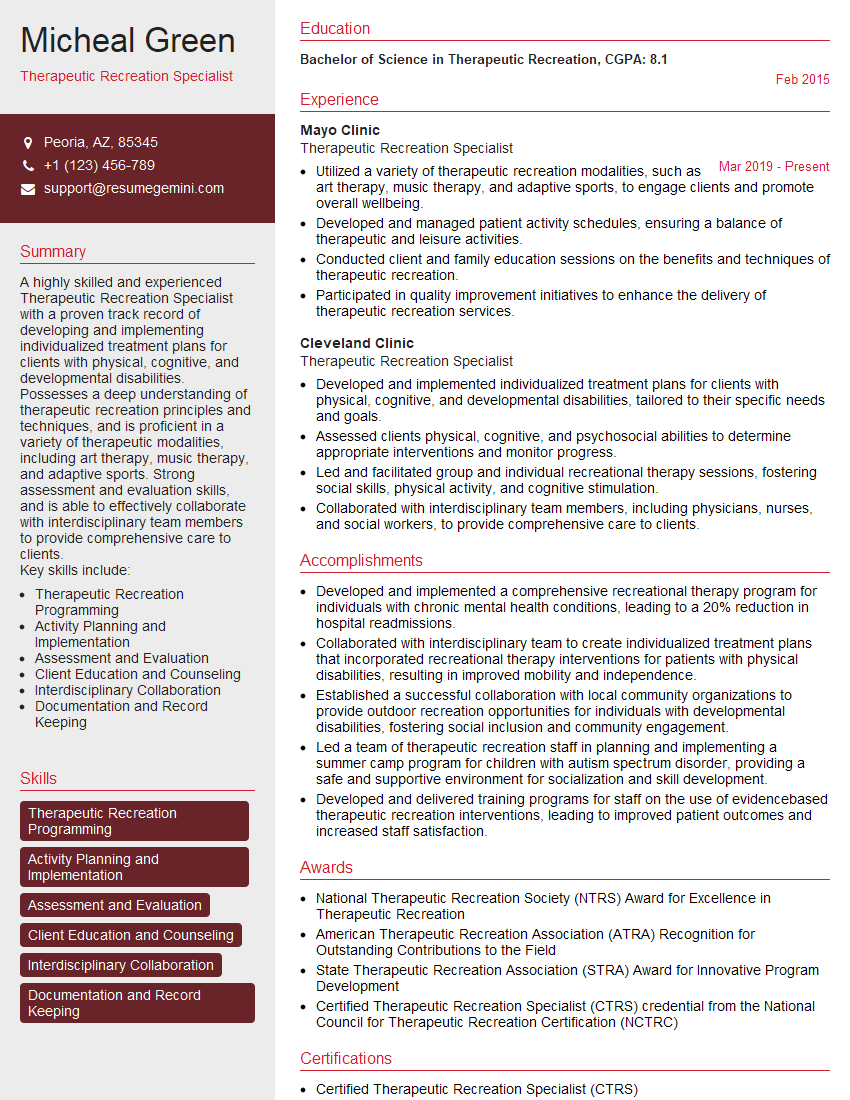The thought of an interview can be nerve-wracking, but the right preparation can make all the difference. Explore this comprehensive guide to Vocational Skills Training for Students with Mental Handicaps interview questions and gain the confidence you need to showcase your abilities and secure the role.
Questions Asked in Vocational Skills Training for Students with Mental Handicaps Interview
Q 1. Describe your experience developing individualized education programs (IEPs) for students with mental handicaps.
Developing Individualized Education Programs (IEPs) for students with mental handicaps is a collaborative and iterative process. It begins with a thorough assessment of the student’s strengths, weaknesses, and learning style. This includes reviewing existing evaluations, conducting observations in various settings, and utilizing standardized and informal assessments to gauge cognitive abilities, adaptive skills, and vocational interests.
The IEP then outlines specific, measurable, achievable, relevant, and time-bound (SMART) goals tailored to the student’s unique needs. For example, a student struggling with social interaction might have a goal of ‘improving communication skills by actively participating in group discussions twice a week for six weeks,’ while another student might focus on mastering a specific vocational skill, such as ‘assembling 10 components per hour with 90% accuracy by the end of the semester.’
The IEP also specifies the types of support and accommodations required, such as assistive technology, modified instruction, or specialized teaching strategies. Regular progress monitoring and adjustments to the IEP ensure the student remains engaged and on track towards their goals. I always involve the student, their family, and relevant professionals to ensure the plan is comprehensive and reflects everyone’s input.
Q 2. What vocational assessment tools are you familiar with and how do you interpret their results?
I am proficient in using a variety of vocational assessment tools. These include standardized tests like the Wide Range Achievement Test (WRAT) to assess academic skills, and the Vineland Adaptive Behavior Scales to evaluate daily living skills. I also utilize interest inventories like the Career Exploration and Planning System (CEPS) to gauge vocational interests and preferences. Beyond standardized testing, I heavily rely on observational assessments and work samples to gain a holistic understanding of a student’s capabilities and limitations.
Interpreting results involves looking beyond raw scores. For example, a low score on a standardized test might not reflect true potential. I consider the student’s overall performance, their effort, and any environmental factors that might have influenced the test results. I use a combination of quantitative and qualitative data to paint a comprehensive picture. This approach ensures I am not just interpreting numbers, but truly understanding the student’s capabilities and learning style within the context of their vocational goals. For instance, a student might score poorly on a written test but demonstrate exceptional practical skills during a hands-on task.
Q 3. Explain your approach to teaching job-seeking skills to students with diverse learning needs.
Teaching job-seeking skills to students with diverse learning needs necessitates a highly individualized and practical approach. My approach combines direct instruction with hands-on activities and real-world simulations. I start by building a strong foundation in self-advocacy and communication skills.
- Resume and cover letter writing: We work collaboratively, starting with brainstorming their skills and experiences, then moving to developing targeted resumes and cover letters for specific job applications.
- Mock interviews: I conduct realistic mock interviews, providing constructive feedback on their responses and interview techniques. This helps them build confidence and reduce anxiety.
- Job application strategies: I teach them how to effectively search for jobs, complete applications online, and navigate the job market. This often involves using adaptive technology and personalized support.
- Workplace etiquette: We discuss appropriate workplace behavior, including punctuality, communication protocols, and teamwork. Role-playing scenarios are incorporated to practice these skills.
The entire process is tailored to the individual’s needs and learning style, incorporating visual aids, hands-on activities, and frequent opportunities for practice and feedback.
Q 4. How do you adapt teaching methods to accommodate various learning styles and cognitive abilities?
Adapting teaching methods is crucial for effective vocational training. I use a multi-sensory approach, catering to visual, auditory, and kinesthetic learners. For example, I might use visual aids like diagrams or videos for visual learners, provide verbal explanations and discussions for auditory learners, and incorporate hands-on activities or simulations for kinesthetic learners.
Students with different cognitive abilities require different levels of support and instruction. I differentiate instruction by providing varied levels of scaffolding – from extensive support for students with significant cognitive challenges to minimal support for students with higher cognitive abilities. This could involve breaking down tasks into smaller, manageable steps, offering visual cues, or using assistive technology to support learning.
Regular formative assessments are crucial. These assessments allow me to identify individual learning needs, adjust my teaching strategies accordingly, and provide appropriate support. For example, if a student struggles with a specific concept, I will use different teaching strategies, provide additional practice, or modify the assignment to better suit their learning style.
Q 5. What strategies do you employ to address challenging behaviors in the vocational training setting?
Addressing challenging behaviors requires a proactive and positive approach. I focus on identifying the root cause of the behavior. This might involve collaboration with psychologists or other professionals to understand the underlying reasons for the behavior and to create a behavior intervention plan (BIP).
Positive reinforcement strategies are crucial. Rewarding positive behaviors and ignoring minor disruptive behaviors can help to reduce challenging behaviors. I also utilize techniques like clear expectations, consistent routines, and visual supports to help students understand expectations and manage their behavior.
When more intensive interventions are needed, I collaborate with the student’s support team to develop and implement a BIP. This plan involves identifying specific behaviors, establishing clear goals, and defining specific interventions. The plan is regularly monitored and revised as needed to ensure its effectiveness.
For instance, a student exhibiting aggression might benefit from a calming corner or quiet space where they can de-escalate. Consistent positive reinforcement, coupled with clear expectations about appropriate behavior, is often the most effective long-term solution.
Q 6. Describe your experience in collaborating with parents, guardians, and other professionals.
Collaboration is paramount. I regularly communicate with parents/guardians, updating them on their child’s progress, sharing observations, and actively involving them in the IEP process. I also collaborate extensively with other professionals, including special education teachers, therapists, and job coaches. Regular meetings and shared information ensure a consistent and supportive learning environment for the student.
Building strong relationships with parents and guardians is key. I use various communication methods, including regular meetings, emails, phone calls, and progress reports. Open communication fosters trust and allows for a unified approach to the student’s education and vocational development. This partnership approach ensures the student receives consistent support and guidance across all aspects of their lives.
Collaboration with other professionals allows for a holistic approach, considering the student’s diverse needs and potential challenges. A collaborative approach also helps provide a wider range of support and expertise to address any issue the student might face, whether it’s academic, emotional, or social.
Q 7. How do you ensure the safety and well-being of students during vocational training activities?
Ensuring student safety and well-being is my top priority. This involves creating a safe and supportive learning environment, free from hazards and potential risks. This includes regularly inspecting the work area, ensuring proper equipment is used, and providing safety training tailored to each student’s needs and abilities.
I establish clear safety procedures and rules. These rules are clearly explained and displayed, reinforced regularly, and adapted to the student’s understanding. We regularly practice emergency procedures and discuss what to do in different situations. Students with specific needs might require individualized safety plans.
Supervision is crucial. The level of supervision is adjusted according to the student’s abilities and needs. Students with more significant support needs may require one-on-one supervision, while others may be able to work independently with regular check-ins.
Finally, I continuously monitor the environment for potential risks and make adjustments as necessary. Regular communication with students and staff about safety concerns is also vital. This proactive approach creates a secure and encouraging environment where students can focus on their learning and development.
Q 8. Explain your understanding of supported employment and its benefits for students with mental handicaps.
Supported employment is a comprehensive approach that helps individuals with mental handicaps obtain and maintain competitive employment in integrated work settings. It’s not about sheltered workshops, but rather about finding a suitable job in the community and providing ongoing support to ensure success. This support can include job coaching, assistance with transportation, and help with navigating workplace challenges.
The benefits are numerous. Supported employment significantly improves self-esteem, boosts independence, increases social interaction, and provides a sense of purpose and accomplishment. Financially, it leads to greater economic self-sufficiency and reduces reliance on social support systems. For example, one of my students, initially hesitant to interact with others, flourished in a supported role at a local cafe. His confidence soared as he learned barista skills and built friendships with coworkers.
Q 9. How do you measure the effectiveness of your vocational training programs?
Measuring the effectiveness of our vocational training programs involves a multi-faceted approach. We track several key indicators. First, we monitor student attendance and participation in training modules. Second, we assess their progress in acquiring job-related skills using standardized assessments, observation, and practical demonstrations. Third, and perhaps most importantly, we track post-training employment outcomes: securing competitive employment, job retention rates, and wage levels. Finally, we conduct regular feedback sessions with employers and students to gauge overall satisfaction and identify areas for improvement. We use both quantitative data (like employment rates) and qualitative data (like feedback from employers and students) to get a holistic picture of our program’s effectiveness.
Q 10. What are some common barriers to employment faced by students with mental handicaps, and how do you address them?
Students with mental handicaps often face numerous barriers to employment, including stigma and discrimination, lack of appropriate job skills, transportation issues, and difficulties with social interaction and communication. Addressing these requires a multi-pronged strategy.
- Stigma and Discrimination: We actively work with employers to educate them about the capabilities of individuals with mental handicaps and highlight the benefits of diversity in the workplace. We also help our students develop self-advocacy skills.
- Skill Development: Our curriculum is tailored to teach relevant job skills, focusing on practical application and transferable skills. We offer individualized training based on each student’s strengths and interests.
- Transportation & Accessibility: We assist in finding affordable and reliable transportation options. We also work to ensure that workplaces are accessible and accommodate any physical needs.
- Social & Communication Skills: We incorporate role-playing and social skills training to improve interaction skills. We also offer support groups to help students build confidence.
For instance, one student struggled with anxiety in social settings. Through tailored coaching and role-playing, we helped them develop strategies to manage their anxiety and interact more confidently with potential employers and coworkers.
Q 11. Describe your experience in job placement and follow-up support.
Job placement is a collaborative process. We start by identifying the student’s interests and skills, and then we work closely with them to find suitable job openings. We develop resumes and cover letters, conduct mock interviews, and provide ongoing job coaching during the initial employment phase. This support can range from assistance with task completion to conflict resolution.
Follow-up support is crucial for long-term success. We conduct regular check-ins with both the student and the employer. We address any challenges that arise and provide ongoing support and encouragement to ensure job retention. We might adjust the level or type of support based on the individual’s needs. Our goal isn’t just to place students in jobs, but to help them thrive in their chosen careers.
Q 12. How do you utilize assistive technology to enhance student learning and participation?
Assistive technology plays a vital role in enhancing student learning and participation. We utilize a range of tools depending on individual needs. For example, students with visual impairments might benefit from screen readers or Braille displays, while those with auditory processing challenges may use audio recorders and note-taking software. Students with attention deficits may use organizational tools like planners and reminder apps.
We also utilize adaptive technology for vocational training. This could include specialized software for specific job skills (e.g., graphic design software with voice commands) or adaptive equipment to modify workstations for physical needs. The key is to ensure that assistive technology is integrated seamlessly into the learning process, and that students are given adequate training and support to use it effectively. We see assistive technology as an empowerment tool, facilitating greater independence and participation.
Q 13. How do you promote independent living skills within your vocational training program?
Independent living skills are integrated throughout our vocational training program. We don’t treat them as a separate module, but as essential components of successful employment and overall well-being. For instance, we cover money management, budgeting, and basic household chores during our life skills workshops. We also provide instruction on navigating public transportation, accessing community resources, and self-advocacy techniques.
We emphasize practical application through role-playing and real-world scenarios. For example, students might practice budgeting for groceries or learn to navigate a bus route. We collaborate with community organizations to provide opportunities for practicing these skills in safe and supportive environments. The ultimate aim is to equip our students with the confidence and skills needed to live as independently as possible.
Q 14. What are your strategies for building rapport and trust with students with mental handicaps?
Building rapport and trust is paramount. It requires patience, empathy, and a genuine commitment to understanding each student’s unique needs and challenges. We create a safe and supportive learning environment where students feel comfortable expressing themselves without fear of judgment. We actively listen to their concerns, celebrate their successes, and acknowledge their struggles. We always approach them with respect and dignity, recognizing that they are individuals with diverse strengths and capabilities.
We incorporate positive reinforcement and individualized attention. For example, celebrating small achievements helps build confidence and motivates them to continue striving for their goals. We actively involve them in the development of their individual learning plans, fostering a sense of ownership and control over their learning journey. This participatory approach significantly contributes to fostering trust and mutual respect.
Q 15. Describe your experience with different vocational training methodologies.
My experience spans various vocational training methodologies, all tailored to the unique needs of students with mental handicaps. I’ve employed approaches like task analysis, breaking down complex tasks into smaller, manageable steps, making learning accessible and less overwhelming. For instance, teaching someone to make a sandwich might involve separate lessons on bread selection, spreading condiments, and arranging fillings. I’ve also utilized modeling and imitation, where I demonstrate a skill and students replicate it. This is especially effective with students who benefit from visual learning. Positive reinforcement and behavior modification are integral; celebrating successes, however small, boosts confidence and encourages engagement. Finally, I incorporate hands-on, project-based learning, allowing students to apply their skills in real-world scenarios, fostering independence and practical experience.
In addition to these core methods, I adapt my approach based on individual learning styles and diagnosed conditions. For example, a student with auditory processing difficulties might benefit from visual aids and demonstrations, while a student with ADHD may require more frequent breaks and structured routines.
Career Expert Tips:
- Ace those interviews! Prepare effectively by reviewing the Top 50 Most Common Interview Questions on ResumeGemini.
- Navigate your job search with confidence! Explore a wide range of Career Tips on ResumeGemini. Learn about common challenges and recommendations to overcome them.
- Craft the perfect resume! Master the Art of Resume Writing with ResumeGemini’s guide. Showcase your unique qualifications and achievements effectively.
- Don’t miss out on holiday savings! Build your dream resume with ResumeGemini’s ATS optimized templates.
Q 16. How do you incorporate community-based learning opportunities into your vocational training curriculum?
Community-based learning is crucial for preparing students for independent living and employment. We achieve this through various partnerships. For example, we collaborate with local businesses to provide internships and job shadowing opportunities, allowing students to experience real work environments and develop valuable job skills. We also work with community organizations to provide volunteer placements, developing teamwork and social skills. These experiences are structured to be progressively challenging, building confidence and competence.
We also involve the community in our training programs. Local gardeners may teach basic horticulture, while culinary experts could demonstrate essential kitchen skills. This enriches the learning experience, introduces students to different job possibilities, and fosters a sense of belonging within the wider community.
Q 17. What are the ethical considerations in teaching vocational skills to students with mental handicaps?
Ethical considerations are paramount. Student autonomy and self-determination are central; we ensure that students participate in choices about their training paths and goals. Respect for individual differences is crucial; we celebrate diversity and avoid making assumptions about students’ abilities based on their diagnosis. We must also ensure confidentiality, protecting sensitive information about students’ mental health. Avoidance of exploitation is essential; we ensure students are not used for unskilled labor, and that all internships and placements are safe and supportive.
Finally, we promote inclusivity and fair access. We advocate for inclusive educational practices, removing barriers to participation for students with disabilities, and ensuring they receive equal opportunities in learning and future employment.
Q 18. Explain your knowledge of relevant legislation and regulations concerning special education.
My understanding of relevant legislation and regulations, such as the Individuals with Disabilities Education Act (IDEA) in the US (or equivalent legislation in other countries), is comprehensive. IDEA mandates free and appropriate public education (FAPE) for eligible students with disabilities, including vocational training tailored to their individual needs. I understand the legal requirements for developing Individualized Education Programs (IEPs), which outline specific goals, services, and accommodations for each student. I am also familiar with the Americans with Disabilities Act (ADA), which protects individuals with disabilities from discrimination in employment and ensures workplace accessibility.
This knowledge informs all aspects of our training programs, from curriculum design and assessment methods to the provision of appropriate accommodations and supports. We ensure strict adherence to all legal requirements, fostering a safe, inclusive, and equitable learning environment for all students.
Q 19. Describe your experience with students with specific mental health diagnoses (e.g., autism, Down syndrome).
I have extensive experience with students diagnosed with various mental health conditions, including autism spectrum disorder (ASD) and Down syndrome. My approach is highly individualized, adapting teaching strategies to suit specific needs. For students with ASD, I often use visual schedules, clear and concise instructions, and predictable routines to minimize sensory overload and anxiety. I might incorporate repetitive tasks to leverage their strengths and build confidence.
For students with Down syndrome, I focus on building communication skills, using visual cues and simple language, and breaking tasks into smaller, more achievable steps. I emphasize positive reinforcement and celebrate progress, fostering their independence and self-esteem. I collaborate closely with their families and other specialists to create a holistic and supportive learning environment.
Q 20. How do you adapt your communication style to meet the needs of individuals with varying communication abilities?
Adapting communication is crucial. For students with limited verbal communication, I rely heavily on visual aids, such as pictures, symbols, and written instructions. I use Augmentative and Alternative Communication (AAC) systems, such as picture exchange systems (PECS) or speech-generating devices (SGD), where appropriate. For students with auditory processing challenges, I use clear, concise language, face them directly when speaking, and incorporate visual cues. I also pay close attention to nonverbal cues, such as body language, to ensure effective communication.
For students with expressive language difficulties, I use open-ended questions that encourage nonverbal responses, allowing them to express themselves in ways that work best for them. Regular feedback checks and adjustments to my communication style based on the student’s response are essential.
Q 21. How do you facilitate teamwork and collaboration among students with diverse needs?
Facilitating teamwork requires careful planning and structure. I create collaborative projects designed to leverage each student’s strengths. For example, in a group project involving gardening, a student with strong organizational skills could manage supplies, while another with manual dexterity excels at planting. I provide clear expectations and roles, breaking down tasks into manageable parts. I emphasize positive peer interaction, encouraging students to support and learn from each other.
To address diverse needs, I provide individualized support within the group setting. Some students may require more guidance or adapted instructions, while others thrive with more independence. I model effective collaboration and communication, creating a supportive and inclusive environment where students feel comfortable contributing and working together towards shared goals. Regular group reflection sessions help them understand the impact of their contributions on others.
Q 22. What are your strategies for managing time effectively in a fast-paced vocational training environment?
Effective time management in a fast-paced vocational training environment for students with mental handicaps requires a structured approach. It’s not just about scheduling; it’s about adapting to individual needs and learning styles.
- Visual Schedules: I utilize visual schedules and timers, breaking down tasks into smaller, manageable chunks. This helps students understand the sequence of activities and expectations, reducing anxiety and improving focus. For example, a student learning basic cooking might have a visual schedule showing each step: prep, cook, clean.
- Individualized Plans: I create individualized lesson plans that consider each student’s pace and attention span. Some students might need more frequent breaks, while others can sustain longer periods of focused work. We regularly adjust the plans based on their progress and feedback.
- Positive Reinforcement: Frequent positive reinforcement and celebration of small successes are crucial. Acknowledging their efforts and progress boosts motivation and helps maintain momentum, leading to improved time management skills over time.
- Collaboration: Working closely with support staff, parents, and therapists is essential for a holistic approach. This ensures consistent strategies are used across different settings, reinforcing the time management skills learned in the training environment.
Q 23. How do you handle situations where a student struggles to grasp a particular skill or concept?
When a student struggles, I employ a multi-faceted approach focusing on understanding the root cause. It’s rarely just a lack of ability; it’s often linked to underlying learning differences, emotional barriers, or even sensory sensitivities.
- Differentiated Instruction: I modify the instruction method. This might involve using different teaching aids (visual aids, hands-on activities, simulations), breaking down tasks into smaller steps, or providing more frequent feedback and support.
- Assistive Technology: Utilizing assistive technologies, such as specialized software or adaptive equipment, can significantly improve a student’s ability to grasp certain skills. For instance, a student struggling with fine motor skills might benefit from adaptive cutlery or specialized writing tools.
- Assessment and Adjustment: I regularly assess the student’s progress and adjust my teaching methods accordingly. This might include changing the pace of instruction, providing additional practice, or exploring alternative learning styles.
- Collaboration with Specialists: I work collaboratively with occupational therapists, speech therapists, and other professionals to address any underlying challenges affecting the student’s learning. This holistic approach ensures we’re addressing all aspects of the student’s needs.
Q 24. How do you maintain accurate and up-to-date records of student progress?
Maintaining accurate and up-to-date records of student progress is paramount. I use a combination of methods to ensure comprehensive and readily accessible information.
- Digital Record Keeping: I utilize a secure, password-protected digital system for storing student data, including attendance, assessment results, individualized education programs (IEPs), and progress notes. This allows for easy tracking and analysis.
- Regular Progress Monitoring: I conduct regular assessments using various methods (observation, checklists, tests, portfolios) to monitor student progress. This data is documented meticulously, ensuring a clear picture of their development.
- Data Visualization: I utilize graphs and charts to visually represent student progress, making it easier to identify trends and areas where additional support might be needed. This also allows for effective communication with parents and other stakeholders.
- Regular Data Review: I regularly review student data to identify areas for improvement in my teaching strategies. This ensures the instruction remains effective and responsive to individual needs.
Q 25. How do you ensure the confidentiality and privacy of student information?
Confidentiality and privacy are of utmost importance. I adhere strictly to all relevant data protection regulations and school policies.
- Secure Data Storage: Student information is stored securely in password-protected digital systems with access limited to authorized personnel only.
- Compliance with Regulations: I am fully compliant with all relevant data protection regulations, ensuring all information is handled according to legal and ethical standards.
- Confidential Communication: I maintain confidentiality when discussing student information with parents, colleagues, or other stakeholders. Any communication is done in a private setting, and only necessary information is disclosed.
- Data Minimization: I only collect and retain the minimum amount of student data necessary for their learning and progress tracking.
Q 26. Describe your experience with crisis intervention and de-escalation techniques.
Crisis intervention and de-escalation are critical skills in this field. I have received extensive training in these areas.
- Recognizing Warning Signs: I am trained to recognize warning signs of escalating behavior, such as changes in body language, verbal cues, or increased anxiety levels. Early recognition is key to preventing crises.
- De-escalation Techniques: I employ various de-escalation techniques, such as active listening, calm and reassuring communication, providing choices, and creating a safe space. The goal is to reduce the student’s emotional arousal and find a resolution.
- Crisis Response Plan: Our school has a well-defined crisis response plan that I am fully trained to implement. This involves knowing the appropriate procedures to follow and how to contact the necessary support staff.
- Ongoing Training: I regularly participate in professional development opportunities related to crisis intervention and de-escalation to maintain and enhance my skills.
Q 27. How do you stay current with best practices and advancements in the field of special education vocational training?
Staying current with best practices is essential. I actively engage in professional development activities to enhance my knowledge and skills.
- Professional Development Courses: I regularly participate in workshops, conferences, and online courses related to special education and vocational training. These opportunities provide updates on the latest research, teaching strategies, and assistive technologies.
- Professional Journals and Publications: I read professional journals and publications to stay informed about current research and best practices in the field.
- Networking with Colleagues: I actively network with colleagues and experts in the field through professional organizations and online communities to share ideas and learn from others’ experiences.
- Mentorship: I seek mentorship opportunities from experienced professionals to receive guidance and feedback on my practice.
Q 28. Describe your experience using data to inform instructional decisions.
Data-driven decision-making is crucial for effective teaching. I use data to inform my instructional decisions at all levels.
- Assessment Data: I analyze student assessment data to identify areas of strength and weakness, informing the development of individualized learning plans. For instance, if assessment shows a student is struggling with a particular skill, I adjust my instruction to provide more support in that area.
- Progress Monitoring Data: I use progress monitoring data to track student progress and adjust my teaching strategies as needed. If a student isn’t progressing at the expected rate, I might explore alternative teaching methods or seek additional support.
- Feedback from Students and Colleagues: I use feedback from students, parents, and colleagues to inform my instructional decisions. This feedback helps identify areas where my teaching can be improved and ensures a student-centered approach.
- Data Analysis and Reflection: I regularly review and analyze student data to reflect on my teaching practices and identify areas for improvement. This ensures my instruction is effective, efficient, and responsive to individual student needs.
Key Topics to Learn for Vocational Skills Training for Students with Mental Handicaps Interview
- Individualized Education Program (IEP) Development and Implementation: Understand the process of creating and adapting IEPs to meet the unique needs of students with mental handicaps, including the selection of appropriate vocational skills training.
- Assessment and Evaluation Techniques: Learn about various methods used to assess student strengths, weaknesses, and learning styles, and how these assessments inform the design of vocational training programs. This includes practical experience discussing specific assessment tools and their application.
- Adaptive Teaching Strategies: Explore diverse instructional approaches tailored to accommodate different learning styles and cognitive abilities. This could include examples of modifying teaching materials or adjusting classroom environments.
- Job Skill Development and Training Methods: Familiarize yourself with various training methods for developing job-related skills, such as on-the-job training, simulated work environments, and community-based learning experiences. Consider the practical application of these methods in different vocational settings.
- Supported Employment and Job Placement Strategies: Understand the role of support staff in assisting students with job placement and ongoing support in the workplace. Explore strategies for successful job placement and retention.
- Collaboration with Families and Support Networks: Learn about the importance of effective communication and collaboration with families, therapists, and other professionals involved in the student’s support system.
- Legal and Ethical Considerations: Understand relevant legislation and ethical guidelines related to the education and employment of individuals with mental handicaps.
- Technology Integration in Vocational Training: Explore how assistive technologies and other technological tools can enhance learning and job performance for students with mental handicaps.
- Addressing Behavioral Challenges and Support Strategies: Understand common behavioral challenges faced by students with mental handicaps and strategies for effective intervention and support.
- Career Exploration and Life Skills Training: Discuss the importance of career exploration activities and the integration of life skills training into vocational programs.
Next Steps
Mastering Vocational Skills Training for Students with Mental Handicaps is crucial for a rewarding career focused on supporting and empowering individuals. A strong resume is your key to unlocking opportunities. Building an ATS-friendly resume significantly increases your chances of getting noticed by potential employers. ResumeGemini is a trusted resource to help you craft a professional and effective resume that showcases your skills and experience. Examples of resumes tailored to Vocational Skills Training for Students with Mental Handicaps are available to guide you. Take the next step towards a fulfilling career – create your best resume today!
Explore more articles
Users Rating of Our Blogs
Share Your Experience
We value your feedback! Please rate our content and share your thoughts (optional).
What Readers Say About Our Blog
Hi, I’m Jay, we have a few potential clients that are interested in your services, thought you might be a good fit. I’d love to talk about the details, when do you have time to talk?
Best,
Jay
Founder | CEO
